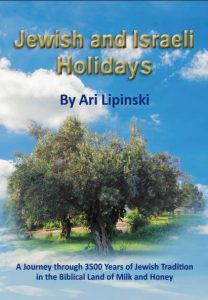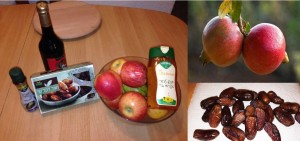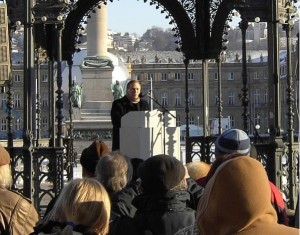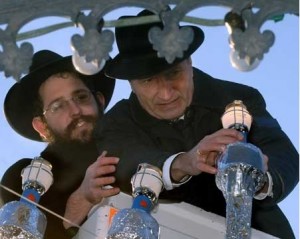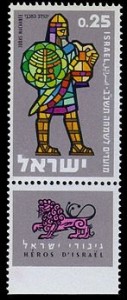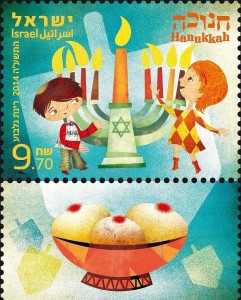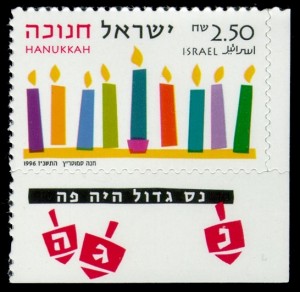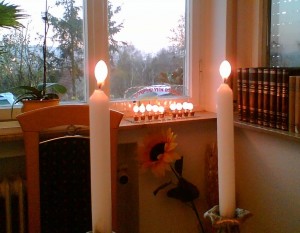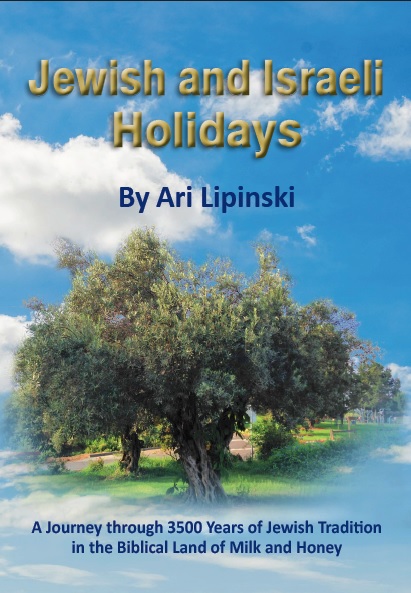JEWISH HOLIDAYS – Biblical Origin, Traditions, Prayers, Hebrew Names
Ari Lipinski explains Jewish and Israeli Holidays: NEW: “Jewish and Israeli Holidays”
For the upcoming holidays you may find the new book by Ari Lipinski, published today, very enriching. In it I offer the readers for the first time in English pearls of wisdom, descriptions, and explanations about 37 Jewish and Israeli holidays and days of remembrance in one volume and in chronological order according to the Jewish calendar. The book (available on Amazon) presents famous Bible commentaries of Jewish sages and rabbis (including Rashi, Maimonides, Nachmanides, Abarbanel) about the Torah sources of the different holidays and their customs and traditions spanning 3800 years.
The holidays covered include Pesach (Passover), Shavuot (Feast of Weeks), Rosh HaShana (The Jewish New Year), Yom Kippur (Day of Atonement), Sukkot (Tabernacles), Hanukkah (Holiday of Lights), Tu BiShvat (New Year of the Tree), Purim, Yom HaShoa (Holocaust and Heroism Remembrance Day), Yom HaZikaron LeChalalei Ma’arachot Israel (Memorial Day for the Fallen Soldiers of the Wars of Israel and Victims of Actions of Terrorism), Yom HaAzmaut (Israel’s Independence Day) and Jerusalem Day. Some well-known prayers and blessings relevant to the major holidays are provided and explained.
I also share with the readers special personal holiday stories of wisdom relating to world-famous historic figures and events in Israel’s history. Famous holiday customs and traditional holiday foods are described and explained. Jewish wisdom about trees and the 7 Species of the Land of Israel mentioned in the Bible enrich the holiday experience.
And much more…
Biblical, historical, and Hebrew background, customs and traditional food of the various holidays.
Below you find the Holidays explained according to their chronological order in the Jewish calendar. Check for the required holiday by down scrolling further on this page. See Updates and pictures.
The Holidays listed are: Rosh HaShana ראש השנה (Jewish New Year), Zom (Fast Day) Gedalya on 3rd of Tishrei, Yom Kippur יום כיפור (Day of Attonement), Sukkot סוכות (Tabernacles), Simchat Thora שמחת תורה (The Joy of the Thora), Shemini Azeret שמיני עצרת (The Assembly at the 8th Day), Hanukkah חנוכה (The Holiday of Lights), Tu BiShevat ט”ו בשבט (New Year of the Trees), Zom (Fast Day) 10th of Tevet, Purim פורים and Taanit Esther, Pessach פסח (Passover) and Chag HaMatzot, Yom HaSHOA ve HaGevura יום הזכרון לשואה ולגבורה (The Israeli Memorial Day for the SHOA and Heroism), Yom HaZikaron leChalelei Zahal uMaarchot Israel יום הזכרון לחללי צה”ל ומערכות ישראל (The Memorial Day for the IDF fallen soldiers, the israeli war and terror victims), Yom HaAzmaut יום העצמאות (Israel’s Independence Day), Lag BaOmer ל”ג בעומר (33 rd Day of counting the Omer since Pessach), Yom Jerushalayim יום ירושלים (Liberation Day of Jerusalem in the 6-Day War 1967), Shavuoth שבועות (The Holiday of 7 Weeks since Pessach, ‘Pentecost’), Zom 17th of Tamuz צום י”ז בתמוז (Fast Day of commemorating the Fall of Jerusalem’s Wall, The breaking of the first Tables of the 10 Commandments and other events listed in article.) , Zom 9th of Av צום ט’ באב ( Fast Day comemmorating the two Jewish Temples in Jerusalem which were destroyed on the same day: the first Temple destroyed by Nebucadnezar in 586 b.c. and the second Temple by Titus in the year 70 a.c.).
The number 7 is a holy significance since the seven days of The Creation.
The following text is under copy right © Ari Lipinski, since it is based on chapters from the Bible commentary book by Ari Lipinski which is in the making.
Rabbi Zvi David Hoffmann has shown, that the Jewish holidays of Rosh HaShanah (the New Year) and Yom Kippur (the Day of Atonement) are directly related to the unique significance of the number seven in the Torah. The 7th day of the week, the Shabbat (Saturday) reminds of the week of the Creation by God. The Shemita year, the 7th year, is the year of rest for the ground in the Land of Israel. Rosh HaShana is the beginning of each year as well as, therefore, the basis for the calculation of the 7th year, the Shemita year. The Shemita year reminds that the land belongs to the LORD. Further more after 7 times Shemita year (7 x 7) comes the Yovel (Jubbilee) year which is the 50th year. The Jubbilee year is crucial in the laws settling the state of ownership of land pieces in the land of Israel. The idea is to remind the ownership of God. In the Jubbilee year people who lost their land due to debts can get their property back under certain conditions.
The number 7 is also of special importance concerning other major Jewish holidays from the Torah: Sukkot (Tabernacles) lasts for 7 days. It is one of the three major pilgrimage holidays, in which the Israelites went to the Temple in Jerusalem to celebrate. Since Jerusalem is ca. 860 meter high in the mountain, the pilgrimage was percepted and called as holidays of ascendance, geographically and spiritually. Also the pilgrimage holiday of Pesach is related to the number 7. It takes place in the month of Nissan. The month of Nissan is considered in the Torah as one of the four dates which are each called a new year. (Explanations follow below under the specific Holidays.) The first day of the holiday is the actual Pesach holiday. It is followed by the week called in the Torah “Chag Ha Matzoth” ( the Feast of Unleavened Bread). Nowadays people call all the 7 days of Pesach and Chag HaMatzoth with the one name of “Pesach Holiday”. Seven weeks after Pesach the Shavuot Holiday (Pentecost) takes place. The 7 weeks counted from Pesach to Shavuot undergo a daily special counting called “Sefirat HaOmer” (the counting of the Omer). The Omer is a biblical measure of a barley quantity which is relevant for a sacrifice (it is ca. 3,64 liters).
The holidays Rosh HaShana, Yom Kipur and Sukkot take place in the month of Tishrey, which is the 7th month of the year. The year (of the kings) begins biblically in the month of Nissan. The pilgrimage holiday Sukkot takes place in the 7th month after Pesach. (Note: Pesach is in Nissan, which is one of the four Jewish dates called a New Year.)
In Jerusalem there are 7 holidays defined as non working holidays: 2 days in Pesach (at the beginning and at the end), 1 day in Shavuot, 1 day in Rosh Ha Shana (1 day was during the Temple time and only in the city of Jerusalem. We know of the Rosh Ha Shana being celebrated of 2 days outside of Jerusalem. Today also in Jerusalem Rosh Ha Shana is celebrated for 2 days. Further details see bellow under the holiday of Rosh Ha Shana.), 1 day on Yom Kipur, one day Sukkot and 1 day on Sheminy Azereth at the end of Sukkot. Total: 7 days.
Rosh Hashana – ראש השנה The Jewish New Year ב”ה
is celebrated with Apple, honey, dates and grapes (wine).
22-06-2018 Rosh HaShana Eng-WEBSITE
The Jewish New Year is called in Hebrew “Rosh HaShanah”. “Rosh” means, the head, the sense, and the spirit, as well as the beginning of the calendar year, “HaShanah”. The ‘beginning’ in Hebrew would be; “Reshit” (ראשית), and not “Rosh”. Think of the beginning of the Bible; the first sentence begins with: “In the Beginning”. In Hebrew, the first word in the Bible is “Bereshit” (בראשית).
The day of the Hebrew New Year is also called “Yom Kesse” (יום כסה), because on this day the moon is fully covered. In Hebrew “Lechasot” means to cover. See Psalm 81, verse 4. With the New Year the Jewish month of “Tishrei” (תשרי) begins. “Tishrei” in Babylonian means the Beginning, i.e. the month with which the year begins. This month, during the Torah era was actually the seventh month, because the month of Nissan (ניסן) is the month which begins the spring.
With Rosh HaShanah, begins not only the count of the new year, but this date serves also to calculate the “Shemita” year (שנת שמיטה), the seventh year during which the people of Israel may not cultivate the land of Israel. Furthermore, Rosh HaShanah also serves to calculate the Jubilee year, the “Yovel” year (שנת היובל), the Jubilee sabbatical year. The Jubilee, takes place after seven “Shemita” years were counted. It is the fiftieth year, in which the slaves were freed, and land was returned to its original owners in case it was taken due to debts. Rosh HaShanah is also the beginning of the calculation of the harvest of the wheat, the barley, and all other vegetable, for the purpose of collecting of the tithe (10% tax).
Please see below the date of “Tu BiShvat” (טו בשבט) for the New Year of the Trees (ראש השנה לאילנות), which is in winter. As the fruit of the trees must be calculated according to a different time table than the harvest of the field and of vegetables.
Rosh HaShanah is celebrated for two days. During the temple time, the citizens of Jerusalem celebrated Rosh HaShanah only for one day. Outside Jerusalem (and outside the land of Israel), Rosh HaShanah was celebrated for two days, because the people there had to wait for a messenger from Jerusalem to verify the exact date of the beginning of the year.
The Jewish year is based on the cycle of the moon. It is a lunar calendar. The present Jewish calendar doesn’t vary any longer since Rabbi Hillel, the President of the “Sanhedrin”, set the exact calendar calculation in the year 359 AD. Therefore, no waiting for messengers was necessary anymore.
The origin of Rosh HaShanah is derived from the following two sentences in the Torah, even though the actual words “New Year” do not appear in the text itself. The Day is called the Day of the “Shofar” (יום השופר). A “Shofar” is hollowed ram’s horn. The sound of the Ram’s Horn should, so Jews believe, remind God of his loyal servant Abraham and his binding of Isaac. So, during the Rosh HaShanah prayer the sound of the “Shofar” should remind God of his promises to his beloved Abraham, in order that God hopefully be more forgiving to us, who may have done some wrong doings – not for our sake, but for Abraham’s.
Further, see in the Book Vayikra (ויקרא), Leviticus, chapter 23, verses 23-25; “23 And the Lord spoke unto Moses, saying,24 Speak unto the children of Israel, saying, In the seventh month, in the first day of the month, shall ye have a sabbath, a memorial of blowing of trumpets, an holy convocation. 25 Ye shall do no servile work therein: but ye shall offer an offering made by fire unto the Lord.” (KJV)
The definition of the day in Hebrew is called “Shabaton Zichron Truah” (שבתון זכרון תרועה). The second reference to the Jewish New Year is in the Torah book “Bamidbar” (Numbers), chapter 29, verses 1-6. “And in the seventh month, on the first day of the month, ye shall have a holy convocation; ye shall do no servile work: it is a day of blowing the trumpets unto you. 2 And ye shall offer a burnt offering for a sweet savour unto the Lord; one young bullock, one ram, and seven lambs of the first year without blemish: 3 And their meat offering shall be of flour mingled with oil, three tenth deals for a bullock, and two tenth deals for a ram, 4 And one tenth deal for one lamb, throughout the seven lambs: 5 And one kid of the goats for a sin offering, to make an atonement for you: 6 Beside the burnt offering of the month, and his meat offering, and the daily burnt offering, and his meat offering, and their drink offerings, according unto their manner, for a sweet savour, a sacrifice made by fire unto the Lord.” In these verses, the name of the Ram “Ayil” (איל), is mentioned explicitly as one of the animals for the sacrifice for the purpose of atonement.
The Hebrew word “Shofar” for the cheering blare “Truah” (תרועה), stems from the Hebrew root of the verb “Leshaper” (לשפר), which means to improve. The sound of the “Shofar” is the call for the people to improve themselves ethically in the spirit of Abraham, who took his son Isaac to the binding, thus demonstrating his absolute belief and trust in God.
A characteristic of the Jewish New Year is manifested in the blare sound of the “Shofar”. Celebrating the New Year with the sound of the “Shofar” is a proclamation that the people recognize God as the King of the World. His crowning is celebrated. Rosh HaShanah according to one of the traditions mentioned in the “Talmud” (תלמוד), is also a reminder of the creation of Adam by God.
The Jewish tradition considers the first ten days of the year as the decision-making period, during which the Lord decides the fates of all people. The 10 days are called “HaYamim HaNoraim”, the Days of Awe, in which a person fears God for his judgement. The traditional opinion of the Rabbis after the Temple era considers that on Rosh HaShanah, God makes the initial judgment. The final verdict is officially sealed, so the Jewish tradition, at the end of the tenth day, Yom Kippur, the Day of Atonement. The verdict is “finally ratified”, so to speak, on the day of “Simchat Torah” (שמחת תורה), at the end of the “Sukkot” Holiday (חג הסוכות), the Feast of Tabernacle. This Rabbinical interpretation is based on Psalm 33, verses 13-15: “13 The Lord looketh from heaven; he beholdeth all the sons of men. 14 From the place of his habitation he looketh upon all the inhabitants of the earth. 15 He fashioneth their hearts alike; he considereth all their works.”
The ten days between Rosh HaShanah and Yom Kippur are also called “Asseret Yemei Tshuvah” (עשרת ימי תשובה), the Ten Days of Atonement. During these days, Jews make special efforts of expressing remorse for mistakes and transgressions. One asks for forgiveness from God for mistakes relating to His commandments, but for insults or transgressions against persons, one has to ask them personally for forgiveness. Therefore, Jews wish each other during this time a happy New Year with the words “LeShana Tova Tekatevu ve Techatemu”, which means: “may you be inscribed for a good year and may this judgment be positively sealed by the Lord”.
The most well-known prayer of the New Year among Ashkenazi Jewish communities (originating from Germany, Italy, Central Europe) is called “Unetane Tokef” (ונתנה תוקף). The name means “one recognizes the authority of God”. This prayer dates back to the twelfth century, and is attributed to Rabbi Amnon of Magenza (Mainz in Germany). This prayer belongs to the end (“Musaf”) of the morning prayer of Rosh HaShanah, and is traditionally sung on the two New Year days, and on Yom Kippur (יום כיפור), the Day of Atonement. The believer recognizes the authority and the jurisdiction of God. In the prayer, the nullity of man in relation to the Lord and man’s respectful fear of God is expressed in a poetic way, which is rich in rhymes, so it suits singing well. The text describes the procedure of the judgement starting on Rosh HaShanah until the verdict on Yom Kippur. The Prayer “Unetane Tokef” ends with mentioning the “Seraphim” (שרפים), the angels closest to God, who ask God for His grace.
Here is a link to a Youtube version of the “Unetane Tokef” prayer sung by one of the best known Israeli opera singers, who is also a “Chazzan” (חזן) a cantor, Dudu Fisher: http://www.youtube.com/watch?v=kmsWmvILKHM.
An important traditional custom of Rosh HaShanah is the “Tashlikh” (תשליך). “Tashlikh” means to shake off or cast away. In the afternoon of the first day of Rosh HaShanah, after the midday prayer of “Mincha”, people traditionally go to the sea shore, lake shore, or the river bank (of moving waters) in order to empty their pockets and shake them off well, as symbolically getting rid of one’s sins and wrongdoings of the past year. Thus, a person may face the Lord with a better, cleaner conscience before He may decide the verdict. This tradition of the “Tashlikh” is rooted in the text of the prophet Micah, in chapter 7, verse 19: “He will again have compassion on us; he will tread our iniquities underfoot. You will cast all our sins into the depths of the sea.”
Further famous customs of the Rosh HaShanah-Feast are, for example, that people give each other and eat apples with honey. This is to express the good wishes for a sweet and fruitful year. Many families serve a honey cake for desert. Pomegranate in the meal symbolizes the wish for a year rich in many good deeds. Meaning that one may fulfil many Torah commandments; as many as the numerous grains of the fruit. Dates stand for the wish for a sweet year like the honey, as well as for ending of bad decisions of the local governments regarding Jews in exile. The allusion to honey is related to the dates, and the impression of flowing honey they made upon the 12 scouts touring the Land of Israel. So, they spoke of the Land of milk and honey, both in fluid form.
Jewish communities in various countries in the diaspora have developed further local traditions since the Talmud times. Among these traditions we find the custom to celebrate the beginning of the Jewish New Year with a meal that includes a pumpkin, a zucchini, or rubia (type of small beans). Some communities integrate beetroot, spinach and chard in the festive meal. In Ashkenazi communities (Germany and Central Europe), families in the last centuries used to have small round slices of cooked carrots with cinnamon in the main dish or as a dessert. The round carrot slices should remind of coins, hence expressing the good wishes for a prosperous New Year. And cinnamon reminds us of the smell of incense in the Holy Temple, as described in Exodus, chapter 30, verse 23. Furthermore, since in German the name for cinnamon is “Zimt”, Jews used to call the dish in Yiddish “Zimmes”.
For centuries Jewish communities used to have the head of a fish as a part of the New Year meal. It should express the hope to be rather a head than a tail in society. It expressed the good wish to be a thinking person, and not merely an obedient member of the community. In the Hebrew calendar the month of Nissan, in spring, was considered according to the Torah also as a New Year. This New Year in Nissan served to count the reign of kings. This New Year was also relevant to calculate the sacrifices one should bring to the Temple. The New Year, Rosh HaShana, at the beginning of the Hebrew month Tishrei, in autumn, is to this day the beginning of the Jewish calendar year.
The 15th of the month of Shvat (“Tu BiShvat”), in winter, is called the New Year of the Tree. It was decided by the Rabbis of the Mishna time as the relevant date to count the buds on the fruit trees in the land of Israel. This counting was the basis to calculate the tithe (10 % tax) on the first fruits of the fruit trees. The date was chosen after intensive discussions among the Rabbis, some of whom (the House Shammai), preferred the first of the month of Shvat. The date of “Tu BiShvat” is according to House Hillel.
Footnote 1] “Shofar” is the horn of a Ram. On Rosh HaShana the blowing of the “Shofar” is a symbolic reminder of Abraham. With the binding of Isaac (Genesis, chapter 22), Abraham demonstrated his unconditional faith in God. He trusted that God would surly keep his promise that out of Isaac a numerous nation would spring out. One proof of his confidence one can see in the sentence in which Abraham told his servant to wait until they (Abraham and Isaac) would come back. As we know, Abraham miraculously saw a Ram caught by its horns in the bush, which he took as a sacrifice, after God instructed him not to harm the boy (Isaac). Verse 12: “Do not lay a hand on the boy”. (Incidentally: Isaac was already 37 years of age…) Since in Rosh HaShana and Yom Kippur, the Jewish people are praying for a positive judgement by God, the blowing of the “Shofar” should serve as a call for forgiveness from God. Since the ordinary person may have sinned in the past year the community is asking for forgiveness and mercy on behalf of the special love and respect Abraham earned from God.
The sacrifice of the Ram instead of Isaac was a strong demonstration against the pagan custom of sacrificing children. It illustrated that even if a person was so religiously zealous in his faith, one should not harm a child. It was an important message by God to Abraham and to mankind that God was to be worshiped as a merciful and not as a bloodthirsty God.
The binding of Isaac is considered to be the last of 10 tests which Abraham successfully withstood, proving his deep faith in the LORD and in his covenant and promises both for the future of the family, and the nation, which will come out of Abraham as well as the promise to inherit the promised land (Canaan).
Footnote 2] The rabbinic interpretation concerning Rosh HaShana is based on the Mishna, treatise Rosh HaShana (New Year) chapter 1, paragraph 2 as well as in the Talmud, in the book “Tosefta”, also in the Treatise Rosh HaShana. There we can read that on Rosh HaShana, God decides the verdict, which he seals on Yom Kippur. The verdict becomes valid after “Shemini Atzeret” at the end of the “Sukkot” Holiday.
Machzor: The special prayer book for the High Holidays, Rosh HaShana (the New Year), Yom Kippur (the Day of Atonement), “Sukkot” (Tabernacles), “Pesach” (Passover) and “Shavuot” (Pentecost). The Hebrew word “Machzor” means “the Cycle”. It refers to the repetitive annual holidays according to the Jewish calendar. Originally, the Machzor Prayer books included all the prayers of all days and holidays of the year. They serve mainly the Cantors. Only after printing became popular, did the Machzor become more and more widely used by all people, and not only by the Cantors. The original cycle for the prayers and the Torah readings in the time of the second Temple was three years. The term Machzor is first found in the Mishna, in the “Masechet” (treatise) “Yoma”, chapter 54. Among the first handwritten “Machzor” exemplars is the famous “Machzor” of Worms (Germany) from 1272, and from Nuremberg (Germany) of the year 1331. The first printed “Machzor” known to us is from Rome, dated 1485. (My research relating to the subject of the “Machzor” is mainly based on the study of the famous prayer scholar Abraham Meir Habermann, 1901 – 1980)
The prayer book for the everyday and Shabbat prayers is called “Siddur”. (“Siddur” means in Hebrew the orderly arrangement.)
See More in German at: https://arilipinski.de/rosch-haschana/
(The above text and the above photos relate to copyright © of Ari Lipinski. They are excerpts from the Torah-Commentary book which Ari is working on.)
(Der obige Text und die Fotos stehen unter Copyright © von Ari Lipinski. Sie sind Ausschnitte aus dem Bibel-Kommentar-Buch von Ari, das in Vorbereitung ist.)
Zom (Fast Day) Gedalya on 3rd of Tishrei
Jom Kippur Synagogen-Gebet תפילת יום כיפור * Schofar * ב”ה
Quellen: Bild links: http://pl.wikipedia.org/wiki/Jakub_Weinles * Mitte: Chabbad * rechts: A. Lipinski
Jom Kippur bzw. Jom HaKippurim, der jüdische Versöhnungstag ist ein Feiertag aus der Thora. Im Unterschied zu vielen anderen wichtigen Feiertagen wurde er auch zur Tempelzeit und bis heute nur an einem Tag gefeiert. Andere Feiertage wie z. B. Rosch ha Schana, das Laubhüttenfest, das Pessach-Fest und das Wochenfest werden außerhalb des Landes Israel jeweils an zwei Tagen gefeiert. Im Volksmund gilt er als der höchste jüdische Feiertag. Eigentlich ist der Schabat (Samstag, Ruhetag) nach der Thora heiliger als Jom Kippur. Trotzdem ist Jom Kippur der einzige Fastentag, der wegen Schabat nicht terminlich verschoben wird. Jom Kippur findet am 10. des Monats Tischrei statt. Das Wort Kippur bedeutet Sühne (das Wort Kippurim ist die hebräische Pluralform von Kippur). Markant für diesen hohen Feiertag sind das Fasten und das ganztägige Gebet. Es ist ein arbeitsfreier Tag, ein absoluter Ruhetag. Damit man sich auf das Gebet und auf die Sühnegedanken konzentrieren kann, haben die Gelehrten der Mischna 5 zentrale Verbote mit diesem Tag verbunden: Essen und Trinken, mit Öl verbundene Körperreinigung, das Tragen von Lederschuhen bzw. Sandalen und Geschlechtsverkehr.
Nach der Thora im Buche Exodus (Schemot) stieg Mose auf den Berge Sinai am 1. des Monats Elul, und verbrachte oben 40 Tage. Dann erhielt er zum zweiten mal die zwei Tafeln der 10 Gebote, stieg vom Berge Sinai hinab. Damals hat Gott auf die Bitte von Mose den Kindern Israels die Sünde vom goldenen Kalb durch die Gabe der zweiten Ausgabe der Zwei Tafeln vergeben. Die Sünde des Volkes am goldenen Kalb führte zur Zerbrechung der ersten zwei Tafeln der 10 Gebote durch Mose nach seinem ersten Aufstieg zum Berge Sinai.
Die Thora-Quelle für den Versöhnungstag (Jom Kippur) finden wir in der Thora, im Buch Wajikra (3. Mose), Kap. 16, Vers 29, 30 und 31: “Und dies soll euch zur ewigen Satzung sein: im siebten Monat, am zehnten des Monats, sollt ihr eure Seelen kasteien und keinerlei Arbeit tun, der Eingeborene und der Fremdling, der in eurer Mitte weilt. Denn an diesem Tage wird man Sühnung für euch tun, um euch zu reinigen. von allen euren Sünden werdet ihr rein sein vor dem Ewigen. ein Sabbat der Ruhe soll er euch sein, und ihr sollt eure Seelen kasteien, eine ewige Satzung.”. (Elberfelder Bibel-Übersetzung.)
Wie im Zusammenhang von Rosch ha Schana (dem jüdischen Neujahr) erklärt, dienen die 10 Tage vom Neujahr bis einschließlich Jom Kippur für die Bitte um Vergebung und für Sühne. Die 10 Tage heißen “Aseret Jemei Teschuwa” (die 10 Tage der Sühne), oder auch “Hajamim ha noraim” (die 10 Furcht erregenden Tage) genannt. Nach jüdischer Tradition befindet Gott in diesen Tagen über das Weiterleben der Menschen. Die erste Entscheidung findet am Rosch ha Schana (dem Neujahr) statt. Das Urteil wird am Ausgang des Jom Kippurs (des Versöhnungstages am 10. des Monats) besiegelt, und das Urteil wird am Ende des Laubhüttenfestes am Ausgang von Simchat Thora (die Freude der Thora) rechtskräftig. Während der Tempelzeit fand am Jom Kippur eine außergewöhnliche, einmalige Zeremonie statt: Für die Bitte um Vergebung und Sühne für das ganze Volk der Kinder Israels zu bitten, durfte der Hohe Priester (Ha Cohen ha Gadol) in das Allerheiligste (Kodesch ha Kodaschim), dem heiligsten Bereich des Tempels, eintreten. Der Eintritt in diesen Bereich war während aller anderen Tage des Jahres strikt verboten.
Eine weitere Besonderheit des Jom Kippur-Gottesdienstes im Tempel bestand darin, dass ein Stier und ein Widder geopfert wurden und ein Los zwischen zwei Ziegenböcken zwecks weiteren Opfers vorgenommen wurde. Der Widder diente dazu, Gott an seinen geliebten Knecht Abraham zu erinnern, und somit zugleich Gott an seinen Versprechen an Abraham ins Besondere nach der Bindung Isaaks zu erinnern. Auch das Schofar-Blasen am Jom Kippur (wie zu Rosch HaSchana) soll Gott an die unbedingte Treue Abrahams erinnern, das der Schofar aus dem Horn eines Widders deswegen gemacht wird.
Vor dem ganztägigen Fasten findet ein festliches Mahl statt, dass “Seuda Mafseket” (die trennende Speise) genannt wird. Die aschkenasische Sitte (der Juden Zentraleuropas) kam u. a. dadurch zum Ausdruck, dass man bei dieser “Seuda Mafseket” “Kreplach” gegessen hat. Die Kreplach sind kleine Fleischbällchen in Teig gebacken. Das Fleisch steht symbolisch für Begierde und Sünde. Darum wird das Fleisch mit Teig umhüllt, um sinnbildlich die Sünden abschaffend weg zu decken. Diese Sitte drückt die Erkenntnis aus, dass man höchstwahrscheinlich nicht perfekt ist, und man Sünden abzulegen hat.
In den jüdischen Gemeinden Tunesiens pflegt man die Sitte, bei der Seuda Mafseket Quittenmarmelade (Ribat Chawuschim) zu essen. Marmelade steht symbolisch für die Versüßung und die Quitten für die Inhaftierten, weil auf Hebräisch “He Chawusch” der Häftling bedeutet.
Das berühmteste Gebet von Jom Kippur heißt Kol Nidrei. Es bedeutet “alle meine Gelöbnisse”. Mit diesem Gebet, dass dreimal hintereinander zu Beginn des Jom Kippurs (also am Abend zwischen dem 9. und dem 10. des Monats Tischrei) laut in der Synagoge gesungen wird, beinhaltet eine öffentliche Aufkündigung aller Gelöbnisse, Versprechungen und Verpflichtungen, die eine Person im vergangenen Jahr eingegangen war. Der Sinn der öffentlichen Annulierung besteht darin, vor dem Ewigen und vor seinem Urteil symbolisch ohne uneingehaltenen Versprechungen und Verpflichtungen des vergangenen Jahres zu stehen. Im laufe der Jahrhunderte hat man formelle rabbinische Vorschriften erlassen, um zu verhindern, dass Personen kurz vor dem Feiertag z. B. finanzielle Verpflichtungen bzw. Verträge eingehen, die dann auf Grund des Kol Nidrei Gebetes ihre Gültigkeit etwa verlieren würden.
Die besondere Melodie des Kol Nidrei Gebetes ist den meisten Juden Jahrhunderte lang bekannt gewesen. Mit dem Link können Sie zum wunderbaren YOUTUBE (überspringen Sie die Anfangs-Werbung) des Gebetes gesungen vom berühmten Kantor Naftali Herstik von der großen Synagoge Jerusalems mit „The Cantors“ gelangen. Die besondere Aufzeichnung stammt aus der großen Potugisischen Synagoge Amsterdams im Jahre 2012.
Am Jom Kippur wird aus der Thora ein feststehender Abschnitt, nämlich vom Wochenabschnitt “Achrei Mot” gelesen. Dieser Abschnitt vom Buch Wajikra (3. Mose) von Kap. 16, Vers 1 bis Kap. 18, Vers 30 handelt u. a. von den Begebenheiten nach dem Tod der zwei Söhne Aarons, Nadaw und Avihu. Das bedeutet, dass am Jom Kippur ein inhaltlich für Sühne relevanter Text gelesen wird, und nicht der chronologisch anstehende voletzte Wochenabschnitt aus dem 5. Buch Mose. Zusätzlich wird ein kurzer Abschnitt aus dem Buch “BaMidbar” (4. Mose), dem sogenannten Wochenabschnitt Pinchas, gelesen. Gemeinsam für die beiden gelesenen Textabschnitte ist, dass sie vom zelotischen innersten Glauben der drei erwähnten Personen handeln. Den Prophetenzusatz (Haftara הפטרה), den man nach der Thora-Lesung liest, entnimmt man vom großen Trostpropheten Jesaja aus Kap. 57, Verse 14 bis Ende von Kap. 58. Der berühmte Vers 14 lautet “Und man wird sagen: Machet Bahn, machet Bahn; bereitet einen Weg, hebet aus dem Wege meines Volkes jeden Anstoß hinweg! Kap. 58 endet mit dem tröstenden Satz “Dann wirst du dich an dem Ewigen ergötzen, ich werde dich einher fahren lassen auf den Höhen der Erde, und werde dich speisen mit dem Erbteil Jakobs, deines Vaters; denn der Mund des Ewigen hat gesprochen”. (Elberfelder Bibel-Übersetzung) Nach der Thora-Lesung und der Haftara-Lesung wird das Gebet Jiskor zum Gedenken an die Seelen der verstorbenen Verwandte und an die Opfer der SHOA gesprochen. Es ist dabei eine Sitte, das Personen, deren Eltern noch leben, während des Jiskor-Gebetes den Raum der Synagoge verlassen. Es ist ein Brauch, in diesem Zusammenhang vor bzw. nach Jom Kippur eine Spende für Zedaka (Wohltätigkeit) zu machen. Das Jiskor-Gebet wird außer am Jom Kippur auch am Schmini Azeret (am Ende des Sukkot-Festes, am 7. Tag des Pessach-Festes (eigentlich des Chag Hamazot, weil Pessach nur der erste Tag des Festes heißt), und am Schawuot-Wochenfest.
Im Staat Israel wird Jom Kippur als staatlicher Feiertag eingehalten. Es bedeutet z. B. dass praktisch der gesamte öffentliche Verkehr an Straßen, Seehäfen und Flughäfen vollständig unterbrochen wird. Öffentliche Fernseh- und Radioanstalten unterbrechen ihre Sendungen. (Es sei denn, dass ein Kriegszustand ausbricht.) Es ist ein werkfreier Tag. Also sind alle öffentlichen Stellen und alle Schulen geschlossen. Praktisch sind fast alle Firmen und Geschäfte geschlossen landesweit geschlossen. Nichtjüdische Firmen (wie z.B. Restaurants in arabischen Ortschaften) sind davon nicht betroffen.
Interessanterweise bekunden ca. zwei Drittel der jüdischen Einwohner Israels laut wiederholten Umfragen, dass sie am Jom Kippur fasten, auch wenn nicht alle die fasten, auch zur Synagoge gehen. Ca. die Hälfte der Fastenden verstehen sich ansonsten als relativ säkular. Diese besondere statistische Beobachtung untermauert andere statistische Erhebungen, laut denen der allergrößte Teil (über 90 %) der jüdischen Bevölkerung heiraten religiös mit einem Rabbiner und lassen ihre Söhne traditionell nach 8 Tagen beschneiden. Über drei Viertel der jüdischen Bevölkerung geben in solchen statistischen Umfragen an, dass sie mit ihrer Familie den traditionellen Seder-Abend (das Abendmahl, das zu Beginn des Pessach-Festes stattfindet) mit den traditionellen Matze-Brot begehen. Ich erwähne diese statistischen Angaben, um die besondere Einstellung der überwiegenden Mehrheit der jüdischen Bevölkerung in Israel zu beleuchten. Obwohl man im gewöhnlichen Tagesablauf während des Kalenderjahres den Eindruck gewinnen könnte, als wären die meisten jüdischen Israelis nicht religiös, lässt sich an einigen Eckpfeilern der biblischen Tradition zeigen, dass ein gewisses Maß an Religiosität gekoppelt mit einem hohen Stellenwert von zentralen Traditionen auch bei der sogenannten (sogar bei sich selbst oft als säkular bezeichnenden Bevölkerung) klar zu erkennen ist. Im übrigen pflegte der erste aschkenasische Oberrabbiner des Landes Israels in der modernen Zeit, Rabbiner Abraham Jitzchak Ha Cohen Kuk (1865 – 1935) zu sagen, dass laut der Thora alle Kinder Israels zum heiligen Volk Israel gehörten. Von daher steckt auch in den Juden ein Funke Religiosität, die sich selbst als säkular bezeichnen. Bei Juden, die im Lande Israel leben, gelte es laut Rab. Kuk umso mehr, weil bereits durch ihr Leben im Lande Israel sie eines der wichtigsten Gebote der Thora erfüllen.
Zu den besonderen Bräuchen vor dem Jom Kippur gehört u. a. (wie auch seit dem Neujahr, dem Rosch ha Schana), dass sich Personen einander mit dem Wunsch für ein gutes Jahr (Schana Towa) begrüßen. Viele pflegen auch, sich bei anderen Menschen für eventuelle Verletzungen, Beleidigungen oder Vergehen zu entschuldigen. Es gilt der traditionelle Grundsatz, dass für zwischenmenschliche Vergehen die Menschen sich direkt bei ihren Mitmenschen zu entschuldigen haben. Dafür kann man nicht, nur bei Gott um Vergebung bitten. Die Thora unterscheidet zwischen Vergehen gegenüber göttliche Gebote und Verbote und zwischen Vergehen im zwischenmenschlichen Bereich.
Ein weiterer sehr bekannter Brauch heißt “Kaparot“. Es geht um eine moderne Form des Opferersatzes, der daran erinnern soll, wie zur Tempelzeit durch die sühnende Opferung des Ziegenbocks (des Sündenbocks, “Seir laAzazel“) man um Vergebung der Sünden gebeten hat. Manche opfern dazu einen Hahn, den man vor seiner Schlachtung um den eigenen Kopf dreht, wobei man um sein Leben und um Frieden bittet. Dieser Hahn geht nach seiner Schlachtung als eine Spende an die Armen. Andere Personen setzen die Tradition ohne einen Hahn um. Stattdessen drehen sie einen Umschlag mit einer Spende für die Armen um den Kopf. Die Hauptsache dieser Sitte besteht darin, dass man sich durch eine gute Tat (im Form einer Spende an die Armen) für seine eigenen Fehler entschuldigen möchte.
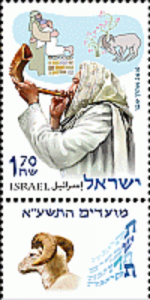 Machzor: Heutzutage nennt man Machzor das Gebetbuch zu den Hohen Feiertagen Rosch HaSchana (Neujahr), Jom Kippur (Versöhnungstag), Sukkot (Laubhüttenfest), Pessach (Gedenken des Auszugs aus Ägypten) und Schawuot (das Wochenfest). Das wort Machzor bedeutet auf Hebräisch ‘Turnus’. Denn ursprünglich war das Machzor-Gebetsbuch die Kollektion der Gebete des ganzen Jahresablaufes. Das Machzor-Buch diente zuerst vor allem den Vorbetern, den Kantoren (Chasan חזן, Chasanim חזנים). Erst nach der Verbreitung der gedruckten Ausgaben ist der Machzor zum Gebetsbuch aller geworden. In der Berechnung der zyklischen Turnuni im Mond-Kalender sind auch Zyklen von drei Jahren und von 28 Jahren bedeutend. Diese haben auch zur Wahl des Begriffs Machzor beigetragen. Den Begriff findet man bereits in der Mishna im Zusatz zum Traktat Joma, Kap. 54. Es gibt handschriftliche Machzor-Ausgaben z.B. aus Worms vom Jahr 1272 und aus Nürnberg vom Jahr 1331. Als erste Druckausgabe ist der Machzor von Rom vom Jahr 1485-6 bekannt. – Bei meiner Recherche bediente ich mich auch den zuverlässigen Angaben des großen Forschers Abraham Meir Habermann (1901-1980).
Machzor: Heutzutage nennt man Machzor das Gebetbuch zu den Hohen Feiertagen Rosch HaSchana (Neujahr), Jom Kippur (Versöhnungstag), Sukkot (Laubhüttenfest), Pessach (Gedenken des Auszugs aus Ägypten) und Schawuot (das Wochenfest). Das wort Machzor bedeutet auf Hebräisch ‘Turnus’. Denn ursprünglich war das Machzor-Gebetsbuch die Kollektion der Gebete des ganzen Jahresablaufes. Das Machzor-Buch diente zuerst vor allem den Vorbetern, den Kantoren (Chasan חזן, Chasanim חזנים). Erst nach der Verbreitung der gedruckten Ausgaben ist der Machzor zum Gebetsbuch aller geworden. In der Berechnung der zyklischen Turnuni im Mond-Kalender sind auch Zyklen von drei Jahren und von 28 Jahren bedeutend. Diese haben auch zur Wahl des Begriffs Machzor beigetragen. Den Begriff findet man bereits in der Mishna im Zusatz zum Traktat Joma, Kap. 54. Es gibt handschriftliche Machzor-Ausgaben z.B. aus Worms vom Jahr 1272 und aus Nürnberg vom Jahr 1331. Als erste Druckausgabe ist der Machzor von Rom vom Jahr 1485-6 bekannt. – Bei meiner Recherche bediente ich mich auch den zuverlässigen Angaben des großen Forschers Abraham Meir Habermann (1901-1980).
Das vom Machzor getrennte Gebetsbuch für den Alltag und Schabbat (Samstag) heißt Sidur סידור (Die Ordnung, Das Geordnete).
Wie Rabbiner David Zwi Hoffmann aufzeigte, sind die Feiertage des Rosch HaSchana und Jom Kippur im Zusammenhang der Thora-Konzeption rund um die Zahl 7 zu verstehen. Die Zahl 7 ist seit der Schöpfungsgeschichte von prägender Bedeutung.
Der siebte Tag der Woche, der Schabbat שבת , erinnert an die Schöpfung durch Gott.
Das Schemita-Jahr שנת שמיטה , das siebte Jahr, ist das Ruhejahr des Bodens im Lande Israel. Rosch HaSchana ist sowohl der anfang eines Jahres, als auch der Anfang der Berechnung der sieben Jahre der Schemita. Das siebte Jahr, das Schemita-Jahr erinnert daran, dass das Land dem Ewigen gehört.
Das Jubel-Jahr, (Schenat Jowel יובל), das 50. Jahr, wird als das fünfzigste Jahr berechnet, nachdem man 7 Mal ein Schemita-Jahr zählt. An dem Jubel-Jahr, dem Jowel, werden die Besitz-Verhältnisse des Bodens wiederhergestellt, um an die Unterordnung vor Gott zu erinnern.
Die Zahl 7 ist auch kennzeichnend für die Dauer wichtiger biblischer Feiertage: Pessach ( genauer gesagt Chag HaMazot) dauert 7 Tage. Sukkot, das Laubhüttenfest, dauert 7 Tage. Das Wochenfest Schawuot findet am Ende der Zählung von sieben Wochen des Omers (Sefirat haOmer ספירת העומר) statt.
Die Feiertage des Jahresanfangs (Rosch HaSchana, Jom Kippur und Sukkot) finden im siebten Monat, Tischrei, statt, da der Monat Nissan, an dem Pessach gefeiert wird, als Jahresanfang galt. Sukkot, das Laubhüttenfest, findet genau 7 Monate nach Pessach statt. Und ferner sind es sieben Tage, an denen (in Jerusalem) die Ruhe von Arbeit (Werkfreiheit) gilt: 2 Tage an Pessach, 1 Tag an Schawuot, 1 Tag an Rosch HaSchana, 1 Tag Jom Kippur, 1 Tag Sukot und 1 Tag Schemini Azeret am Ende von Sukkot. Zusammen: 7.
Nachtrag zu Jom Kippur –
Ein Beispiel zwischenmenschlicher Versöhnung und Demut vor dem Schöpfer.
In Israel ist seit 1973 der Jom Kippur (der Versöhnungstag) unzertrennlich mit der Erinnerung an den Ausbruch des Jom Kippur Krieges (Oktoberkrieges) von 1973 verbunden. Ich gehörte zu den Tausenden ausenden israelischen Soldaten, die zu Hause mit der Familie (ich mit meinen Eltern) gerade bei dem Festmahl vor Beginn des Fastentages, also bei der “Arucha Mafseket” gesessen war, als plötzlich die Meldung vom Militär kam, dass man sofort und dringend zu seiner Einheit zurückkehren müsse. Syrien und Ägypten haben damals kurz vor Anfang des höchsten jüdischen Feiertages Israel gleichzeitig von Norden und von Süden überraschend mit großen Militärmassen überfallen. In diesem ca. dreiwöchigen Krieg, der am 5. Oktober begann, sind über 2.500 israelische Soldaten bei der Verteidigung der Zivilbevölkerung Israels gefallen. Was z. B. die Syrer mit der jüdischen Bevölkerung des Norden Israels hätten (Gott bewahre) anrichten können, lässt sich heutzutage (September 2014) exemplarisch am furchtbaren Gemetzel in Syrien und dem Irak deutlich vorstellen. Auch ich verlor Schulkameraden in diesem Krieg. Der Krieg endete trotz des Überraschungsvorteils und trotz der großen militärischen zahlenmäßigen Überlegenheit der arabischen Armeen von Syrien, Ägypten und dem Irak doch mit einem israelischen Militärsieg. Dieser drückte sich darin aus, dass Israel bis 40 km vor Damaskus und bis 101 km vor Kairo zurückschlagen konnte. Ägypten verlor im Krieg über 15.500 Soldaten und Syrien über 4.000.
Als Ägyptens Präsident Anwar Sadat am 20. November 1977 im israelischen Parlament, in der Knesset, in Israels Hauptstadt Jerusalem seinen sensationellen Friedensaufruf “No more war! No more bloodshed!” öffentlich aussprach, haben die meisten Israelis ihn den Angriff von Oktober 1973 praktisch vergeben, und ihn mit Begeisterung in Israel begrüßt. Nach seiner historischen Rede in der Knesset und der Umarmung mit dem gastgebenden damals amtierenden israelischen Ministerpräsidenten Menachem Begin, kam es zu einer sehr bewegenden Begegnung zwischen Präsident Anwar Sadat und der ehemaligen israelischen Ministerpräsidentin während des Oktoberkrieges.
1973, Golda Meir. Da es kurz nach der Versöhnungszeit von Jom Kippur (also dem Versöhnungstag) war, fragte ein Journalist spontan Frau Golda Meir, ob sie denn nun Präsident Sadat den Angriff von 1973 verzeihe. Alle Anwesenden und die Millionen Zuschauer am TV-Bildschirm bei der Live-Übertragung waren gespannt, zu hören, wie Golda Meir reagieren würde. Es sollte doch nicht zu einem Eklat kommen, nachdem der Gast mit einem derartigen Friedensangebot nach Jerusalem gekommen war. Frau Meir antwortete “Ich verzeihe im alles, außer, das er unsere Jungs gezwungen hatte, auf seine Jungs zu schießen”. Sadat lächelte dankbar, reichte ihr seine Hand und gab ihr das große arabische Kompliment für Weisheit mit den Worten “The old lady!”. Im Orient galt damals noch hohes Alter als Synonym für Weisheit.
Wir, die sowohl den Jom Kippur Krieg 1973 als auch den Besuch Sadats im November 1977 erlebten, waren sehr dankbar, diesen Moment und den darauf folgenden Abschluss des Friedensvertrages zwischen Israel und Ägypten am 24. März 1978 in Camp David in den USA miterlebt haben zu können. Es war eine große Illustration und Manifestation davon, dass Menschen, die vergeben können, auch den Frieden erreichen können.
Viele Beobachter der Friedensverhandlungen zwischen Ägypten und Israel haben die Meinung geteilt, dass die Tatsache, dass Präsident Sadat ein gläubiger Moslem war, Ministerpräsident Begin ein gläubiger Jude war, und der US-Präsident Jimmi Carter ein gläubiger Christ war, den drei Staatsmännern die nötige Demut mit auf den Weg der Verhandlungen gegeben hatte.
Diese Demut vor dem Schöpfer ist auch einer der Kerngedanken des Jom Kippurs.
Hier ein Foto von Ari Lipinski nach Jom Kippur am Kotel (Klagemauer) mit den Tefilin (Gebetsriemen.)
Sukkot – Tabernacles
Das Fest Sukkot סוכות (Laubhüttenfest) findet im 1. Monat, Tischrei statt, und dauert sieben Tage vom 15. des Monats an. Sukkot ist in Hebräisch die Pluralform von Sukka סוכה (eine Laubhütte). (Im Bild sehen wir an der Klagemauer in Jerusalem eine Sukka links oben.)
Das Fest Sukkot dient dazu, daran zu erinnern, dass die Kinder Israels nach dem Auszug aus Ägypten auf dem Weg in das Land Israel in Laubhütten übernachteten, nach dem sie Gott aus der Knechtschaft in Ägypten herausgeholt hatte. Das biblische Gebot besagt, dass man sieben Tage lang in einer Laubhütte zu sitzen hat, an denen aber die meisten Arbeits-tätigkeiten zugelassen sind. (Die Geschäfte sind z. B. offen. Schulen haben Schulfrei.) Sukkot ist der dritte der Pilgerfeiertage der Bibel, an denen man zur Tempelzeit nach Jerusalem gepilgert war. Sukkot heißt in der Thora u. a. auch das Erntefest. Am Ausgang des siebten Festtages findet der Feiertag “Schmini Azeret” שמיני עצרת statt.
Der erste Tag von Sukkot ist ein Ruhetag und danach folgen sechs Feiertage, die keine werkfreie Tage sind. Auf Deutsch bedeutet der Name “Schmini Azeret” “eine Versammlung am achten Tag”. Dieser Feiertag ist wieder ein Ruhetag. Im Lande Israel findet an diesem Tag (dem 22. Tischrei) auch das Fest “Simchat Thora” (die Freude der Thora) statt. Simchat Thora wird außerhalb des Landes Israels am Tag nach “Schmini Azeret” gefeiert. Das Fest Sukkot kommt zuerst im Buch “Schemot” (2. Mose), Kap. 23, Verse 14, 15 vor, sowie in “Schemot” Kap. 34, Vers 22, “Wajikra” (3. Mose) in Kap. 23, Verse 39 bis 43 und im Buch “Ba Midbar (4. Mose) in Kap. 29, Vers 10 bis 39, als auch im Buche “Dewarim” (5. Mose), Kap. 16, Verse 13 bis 16.
Die Laubhütte, also das Hauptmerkmal des Sukkot Feiertages, erinnert zum einen an die provisorische Übernachtung der Kinder Israels solange sie auf dem Weg in das gelobte Land Israel waren. Somit ist die Laubhütte das klassische Symbol für das Provisorische. Darüber hinaus erklären die Gelehrten, dass die Laubhütte daran erinnern soll, dass die Kinder Israels auf dem Weg von Ägypten bis zum Gelobten Land unter dem Schutz der Ehrenwolken (Ananei Ha Kawod ענני כבוד) gewesen sind. Die Ehrenwolken dienten auch dazu, den Kindern Israels tagsüber den Weg in der Wüste zu zeigen. Siehe im Buch Schemot (2. Mose), Kap. 13, Vers 21 und in Kap. 14, Vers 19. Später, nach der Errichtung der Stiftshütte, diente die Ehrenwolke auch dazu, den Kindern Israels zu signalisieren, dass man aufbrechen sollte, und bis zur nächsten Station mit der Stiftshütte weiterziehen sollte. Die besondere Weg weisende Funktion der Wolke ist im Buch Ba Midbar (4. Mose), Kap. 9, Vers 15 nachzulesen. Die Wolke wird auch im Psalm 105 und im Buche Nechemia, Kap. 9, Vers 12 erwähnt. Die Laubhütte des Festes Sukkot erinnert also stellvertretend an die Wunder, die Gott den Kindern Israels auf dem Weg in das Gelobte Land bescherte. Das Dach der Laubhütte (Sukka) wird normalerweise mit Palmenzweigen bedeckt. Dabei gilt, dass man soviel Freiraum zwischen den Zweigen lässt, dass man nachts durch das Dach mindestens drei Sterne sehen kann. Auch diese Beschaffenheit des Daches der Laubhütte soll einen an die Vorsehung erinnern. Eines der bekanntesten Bräuche des Laubhüttenfestes ist die Gast-freundschaft in der Sukka. Man lädt Gäste in die Sukka ein. Dabei sind die 7 Ehrengäste, die Uschpizin אושפיזין (auf Aramäisch Gäste) Abraham, Isaak, Jakob, Josef, Mose, Aharon und David. (Bei manchen Volks-Gruppen wird Josef durch Salomon ersetzt.)
Wie im 3. Buch, Mose Kap. 23, in den Versen 39 bis 43 steht, dass der Sukkot-Feiertag ein Erntedankfest ist, wenn man die Weizenernte einsammelt. Es findet im Herbst statt. Seit dem 1. Pessach-Feiertag war im Anschluss an das Mussaf-Gebet das Gebet, in dem man um Tau bittet, gesprochen.. Ab dem zweiten Tag von Sukkot ändert sich das Gebet von der Bitte um Tau zur Bitte um Regen (Birkat haGeschem bzw. Birkat Geschamim ברכת גשמים). Im Tempel fand eine diesbezügliche besondere Zeremonie statt, der Nissuch Majim (das Wassergiessen) auf dem Altar der Opfer, um damit die Bitte um ein Regen reiches Jahr zu bitten. Natürlich war der Regen für ein Volk, das sich von Landwirtschaft ernährte, von ganz besonderer Bedeutung. Das Tragen des Wassers in geschmückten Behältern vom Shiloach-Brunnen Jerusalems bis zum Tempel war von Tänzen und freudigen musikalischen Zeremonien begleitet, genannt Simchat Beit HaSchoewa שמחת בית השואבה (die Freude des Wasserbrunnens). Man sagte, wer die Freude Jerusalems, die Simchat Beit HaSchoewa, nicht gesehen hat, habe keine Freude gesehen… Es ist laut dem Buch Dewarim (5. Mose), Kapitel 16, Vers 14 ein regelrechtes Gebot, an diesen Feiertagen fröhlich zu sein. Da der Feiertag am Ende der Erntezeit war, war die Freude auch groß.
Über das Gebot hinaus, in der Laubhütte zu sitzen, steht im obigen Text, dass man vier Pflanzen als Zeichen der Freude vor Gott darzubringen hat. Diese vier Pflanzen pflegt man traditionell die vier Minim ארבעת המינים (die vier Arten) zu bezeichnen. Diese sind: eine Zitrusfrucht Pri Ez Hadar פרי עץ הדר (die rabbinische Auslegung spricht von der Frucht, die Etrog אתרוג heißt), einen Lulaw לולב (ein Palmenzweig aus der Baumspitze), drei Myrthezweige, Hadas הדס, und 2 Äste von der Bachweide, Arwei Nachal ערבי נחל (Arwei ist die Pluralform von Arawa, einer Bachweide.). (Nicht zu verwechseln: Arawa ist auch die biblische Bezeichnung der Steppe zwischen dem Yam HaMelach, dem Toten Meer, und dem Roten Meer.) Es ist die Sitte, an den Tagen des Laubhüttenfestes, außer am Schabat-Ruhetag, die vier Arten mit zum Gebet in der Synagoge zu nehmen. Nach der Thoralesung pflegt man eine Runde (Hakafa) gegen die Uhrzeigerrichtung rund um den zentralen Tisch der Synagoge, auf dem die Thorarolle beim Gebet gestellt ist, gemeinsam zu gehen bzw. zu tanzen. (Außerhalb der Lesezeiten der Thora werden die Thora-Rollen im Aron HaKodesch ארון הקודש, dem Schrank des Heiligtums (Thora = Heiligtum) an der Ostwand der Synagoge, also nahe Richtung Jerusalems, aufbewahrt. Am siebten Tag geht man bzw. tanzt man siebenmal um den Thora-Tisch. So erinnern sowohl die sieben Tage des Festes als auch die sieben Runden (Hakafot) an die sieben Tage der Schöpfung.
Die 4 Arten (4 Minim ארבעת המינים) stehen symbolisch für die 4 Typen der Gesellschaft der Kinder Israels: Der Etrog (die Zitrusfrucht) steht für einen Baum, der sowohl Geruch als auch Geschmack hat. Dies entspricht der Person, die sowohl die Thora-Gebote lernt, als auch diese mit guten Taten umsetzt. Der Lulaw (die Palmen-Spitze) erinnert an die gut schmeckenden Datteln, aber hat keinen Geruch. Der Lulaw steht also für die Person, die Thora lernt, aber keine gute Taten dem Lernen folgen läßt. Der Haddas הדס (die Myrthe) hat einen wunderbaren Geruch, aber keinen Geschmack. Die Myrthe steht also für eine Person, die Gutes tut, aber die Thora nicht lernt. Die Arawa ערבה (die Bachweide) hat weder Geschmack noch Geruch. Sie entspricht einer Person, die weder Thora lernt, noch Gutes tut. So erkennt man die vier Arten der Kinder Israels. Und man pflegt die Palmenspitze gemeinsam mit den 3 Myrthen-Zweigen und den zwei Bachweidenzweigen fest zusammen in einer Hand zu halten. Das erinnert daran, dass auch dünne Äste, die einzeln sehr biegsam und zerbrechlich sind, stark und unzerbrechlich werden können, sobald sie gebunden (also gemeinsam) sind. Dies soll den Gedanken illustrieren, dass sobald die Kinder Israels gemeinsam sind, sie durch die Gemeinschaft stark werden.
Eine uralte Münze aus der Zeit des jüdischen Bar-Kochba-Aufstandes gegen die Römer im Jahre 135 zeigt die 4 Arten, und illustriert die uralte Tradition.
Während der Sukkot-Feiertage pflegt man die Sitte, im Synagogen-Gebet die 4 Arten zu halten, und sie schüttelnd in die 4 Windrichtungen (laut Rabbiner HaAri in der Reihenfolge nach Süden, Norden, Osten, nach Oben, nach Unten und nach Westen) zu bewegen. Dabei spricht man ein Psalmgebet, „Ana Adonai Hoschia na“ אנא ה’ הושיעה נא (Bitte, Ewiger, erlöse uns“). Daher heißen diese Riten die Hoscha’anot, die Erlösungsgebete. Am letzten Wochentag des Sukkot-Feiertages pflegt man besonders viele Bitten zu äußern. Daher heißt der Tag vor Schemini Azeret Hoscha’ana raba (Viele Erlösungsbitten). Der Brauch ist, mit 5 Zweigen der Bachweide auf den Boden zu schlagen, um seine Sünden nochmals rechtzeitig noch an diesem Tag abzuschütteln, da am nächsten Tag das Urteil Gottes über die Menschen, so besagt die jüdische Tradition, rechtskräftig werde.
Zur Tempelzeit hat man eine Reihe von täglichen Opfern an den Sukkot-Feiertagen dargebracht. Die Mussaf-Opfer bestanden aus Stieren, Widdern und Schaafen. Die Widder sollen bekanntlich den Ewigen an Abraham und die Bindung Isaaks erinnern. Zusammen in den 7 Tagen waren es 70 Opfertiere an der Zahl. Manche Gelehrte deuteten die Zahl 70 in Zusammenhang der 70 Nationen, die in der Bibel genannt werden. Dieser universelle Bezug des Thora-Gebotes wird im Buch Zacharia in Kapitel 14 deutlich unterstrichen. Heutzutage pflegen Tausende Christen auch deswegen am Jerusalemmarsch während des Sukkot-feiertages teilzunehmen.
Am zweiten Tag des Laubhüttenfestes im Schemita-Jahr (dem siebten Jahr, dem Ruhejahr des Bodens) hat man gemäß des Gebotes im Buch Dewarim (5. Mose) Kapitel 31 in den Versen 9-13 das Volk versammelt, um gemeinsam Thora-Unterricht der Weisen zu bekommen. Dieses Gebot des Hakhels הקהל war eine außerordentlich feierliche Großzeremonie mit Tausenden Menschen. Unter anderem wurde das zentrale Gebet „Höre Israel“ שמע ישראל vom 5. Mose, Kap. 6, Vers 4 laut gesprochen. In diesem Satz bekundet man den Glauben an einem Gott.
Seit 1946 pflegt man in Jerusalem das Gebot des Hakhels vor dem Kotel (der Klagemauer) mit großem Zeremoniell abzuhalten. 1994 hat sogar Israels damaliger Staatspräsident Chaim Herzog öffentlich aus der Thora beim Hakhel gelesen. Herzog stammte aus einer berühmten Rabbinerfamilie.
Es kann an dieser Stelle erwähnt werden, dass das Bibel-Buch des Königs Salomon Kohelet heißt. Wie oben erklärt, bedeutet Hakhel „zu versammeln“ und Kohelet bedeutet „Der Versammler“. Die bekannte deutsche Bezeichnung des Bibel-Buches mit Prediger ist also leider nicht nur wörtlich falsch, sondern auch inhaltlich. Denn, König Salomon nannte sein Buch Kohelet, um das Volk zum gemeinsamen Thora-Lernen rund um die Thora-Rolle einzuladen, also zu versammeln. Salomon wollte nicht einspurig als ‚Prediger‘ das Volk belehren. (Zu den richtigen Übersetzungen der Namen der Bücher der bibel werden Sie in meinem sich im Arbeitsstadium befindlichen Bibel-Kommentar-Buch Weiteres hoffentlich bald lesen können. Unterstützer und Förderer des Buch-Projekts sind herzlich willkommen. Einzelheiten per Email bei lipinskiari@gmail.com gern erhältlich.)
Sukkot ist laut dem Propheten Amos sowohl die trostvolle Verheißung als auch das Gebot, das Land Israel zu besiedeln: Kapitel 9, Vers 11: „An jenem Tage werde ich die verfallene Hütte Davids aufrichten und ihre Risse vermauern und ihre Trümmer aufrichten, und ich werde sie bauen wie in den Tagen vor alters (der Vorzeit)“. (Elberfelder Übersetzung)
Simchat Thora שמחת תורה (Die Freude der thora): Am letzten Tag des Sukkot-Festes, am Schemini Azeret, schließt man die Lesung des letzten Wochenabschnitts der Thora ab, und beginnt sofort im Anschluss daran mit der öffentlichen Lesung des ersten Wochenabschnitts im ersten Buch der Thora, Bereschit (1. Mose), dem Abschnitt Bereschit (Am Anfang). Die große Freude darüber, dass man die Thora (die fünf Bücher Mose) zu Ende gelesen hat, ist sehr groß. Den Mann, der mit der Lesung des ersten Wochenabschnitts, Bereschit, geehrt wird, nennt man Chatan Bereschit חתן בראשית (Der Bräutigam des Bereschit-Abschnitts). Die Thora gilt als eine Braut des Volkes Israels. Am Abend nach Ausgang des Schemini Azeret-Festtages begeht man die Freude über die Thora-Lesung damit, dass man die Thora-Rollen sogar aus der Synagoge herausholt und auf Tischen draußen (sogar mitten auf den Straßen, oder auf öffentlichen Bühnen und Plätzen) stellt. Besondere Bibel-Verse werden gelesen, und dann tragen Männer die Thora-Rollen in Runden (den sogenannten zweiten Hakafot הקפות שניות) um die Thora-Tische. Es ist eine besondere Ehre und Freude, wenn man zum Tragen der Thora-Rolle eingeladen wird. Meistens verbindet man mit der Ehrung als Dank eine Spende für die Armen bzw. für die Synagoge zum Erhalt der Thora-Rollen. Es werden 7 Umrundungen (Hakafot) vorgenommen. Man tanzt dabei mit den Thorarollen, und alle (auch Frauen und Kinder) können die Thora-Rollen anfassen bzw. küssen. (In den Synagogen sind meistens die Bereiche für Männer und Frauen getrennt. Die Thora-Lesung wird von Männern vorgenommen. In den modernen Reform-Synagogen gibt es die Trennung der Bereiche von Männern und Frauen nicht. Es gibt auch Reform-Rabbinerinnen und Vorbeterinnen.)
Die Tatsache, dass die Thora-Rollen geschlossen getragen und gefeiert werden, soll unterstreichen, dass jeder vom Volke Israel einen unmittelbaren Bezug zur Thora hat, ungeachtet dessen, ob er viel oder wenig Thora gelernt hat! Alle sind gleich in der Nähe zur Thora!
Laut dem großen Gelehrten Don Isaak Abrabanel (1437 -1508) hat das Fest simchat Thora seine Wurzel im Land Israel in der Tradition des Hakhels. Laut Abrabanel hat der Hohe Priester am Schmita-Jahr die Thora-Lesung vor dem Volk am Ende des Laubhütten-Festes Sukkot, am Schemini Azeret, der Freude der Thora beendet. (Quelle: Abrabanel zu Dewarim (5. Mose) Kapitel 31, im Wochenabschnitt WaJelech.)
Hanukkah – The Holiday of Lights celebrating the Freedom of Religion
Hanukkah, the Holiday of Lights – celebrating the Freedom of Religion ב”ה
16.7.2017-Hanukkah-Holiday-of-Lights-Ari-Lipinski
© Article by Ari Lipinski www.arilipinski.com
On top of the Menorah of Hanukkah, (Hanukkah Menorah), Hanukkiyah, the 9-branched Hanukkah candlestick, made by Jerusalem pupils, it says: Jerusalem the light of the world
The Jewish Holiday Hanukkah (Holiday of Lights) begins this year on December 16th, 2014 in the evening. The Hanukkah Holiday is not only a Jewish Holiday but also a universal celebration of the freedom of religion. All men should be able to pursue his religious belief. This matters to all people everywhere. The Jewish people starts celebrating this holiday by publicly lighting the first candle of the Menorah of Hanukkah, (Hanukkah-Menorah), Hanukkiah, the 9-arms candlestick. In many cities worldwide public ceremonies of the candle lighting take place. Jews and non Jews join together in these ceremonies. For example: On Dec. 30th 2005 a public ceremony of interreligious get together took place on the central Palace Square, Schlossplatz, in Stuttgart, the capital city of the German federal state Baden-Württemberg. On this occasion the Prime Minister Mr. Guenther Oettinger and the mayor of Stuttgart Dr. Wolfgang Schuster joined Rabbi Shneur Trebnik in lighting the Hanukkah candles on a 6 meter high Hanukkah-Menora, the Hanukkiah. The City fire fighters lifted them with a professional hydraulic stage high to reach the candles. Mr. Ari Lipinski MBA, director of the Jewish community of the state of Württemberg (IRGW) at that time opened the event ceremony elaborating on the universal spirit of the freedom of religion as a common denominator of all people. He referred to the fact that at the same time worldwide similar public candle lighting ceremonies take place. Mrs. Barbara Traub M.A. warmly thanked PM G. Oettinger and Mayor Dr. W. Schuster and explicitly the big audience on the central public place who joined the first common and public interreligious ceremony of lighting the Hanukkah candles commemorating the Jewish struggle for religious freedom. This ceremony takes place since then every year.
The following photos are derived from the Website www.alemannia-judaica.de/chanukka_stuttgart_2005.htm .
From left to right: left photo: director Ari Lipinski, centre photo: Rabbi Shneur Trebnik with PM Guenther Oettinger. Right photo: f.l.t.r.: Ari Lipinski, IRGW-Cantor Arie Mozes, IRGW-Speaker Mrs. Barbara Traub MA, MP of German federate state BW G. Oettinger, Stuttgart Mayor Dr. W. Schuster.
Further examples: US Presidents G.W. Bush, B. Clinton, B. Obama, UK PM T. Blair.
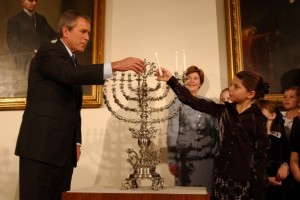
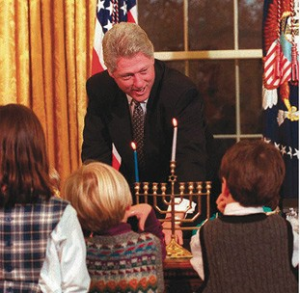
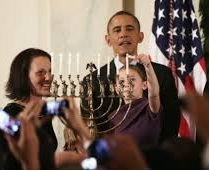
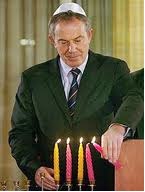
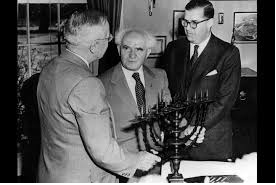 US President H.S. Truman, Israel PM D. Ben Gurion and A. Eban (then Israel’s Ambassador to the USA and to the UN) with a Hanukkah-Menora, the Chanukkiyah.
US President H.S. Truman, Israel PM D. Ben Gurion and A. Eban (then Israel’s Ambassador to the USA and to the UN) with a Hanukkah-Menora, the Chanukkiyah.
In the following article the background and the meaning of terms relating to the Hanukkah Holiday will be explained. For example: Hanukkah חנוכה , Hanukkiah חנוכיה (Hanukkah-Menorah, 9-branched candlestick), Menorah (7-branched Temple candlestick) מנורה, Maccabees מכבים , Hasmoneans חשמונאים , the Hanukkah miracle נס חנוכה , the oil jug קד השמן , Sewiwon (dreidel) סביבון , Sufgania (donut) סופגניה , Leviva (potato pancakes) לביבה , the “Maoz Zur” מעוז צור prayer song, etc. .
The history of Hanukkah: After the Macedonian – Greek dynasty of the Seleucides had conquered Judea (Palaestina) in the year 200 b.c., the new rulers strived to increase their influence. In the year 167 b. C. the Hasmonean Revolt (מרד החשמונאים) started. It is also known as the Maccabee Revolt. The Jews resisted the Greeks because keeping the freedom of religion was at stake, since this liberty was cancelled by the Greek law. For the people of Israel religion is closely interwoven with the national identity.
The Hanukkah Holiday of Lights is not a holiday based on Thora (the books of Moses) commandments. The instructions how to conduct the holiday and how to proceed with it came after the event. The Maccabean Revolt which started in 167 b. C. is historically well documented and archaeologically well known. One central source for the historical information about the events of the Hasmonean upheaval are the books of the Maccabees (1 and 2). They were written originally in Hebrew in the land of Israel (in Judea) obviously shortly after the events had occurred. The books were translated later into Greek. Most translations of these books relay on the Greek version. The books of the Maccabees, though considered very valuable, are not included in the 24 books of the Jewish Bible (Old Testament). They belong to the books called “HaSefarim Ha Chizoniyim” הספרים החיצוניים, the “External Books”. The various Christian Churches have different approaches to the theological status of the Apocrypha. So some Bible translation versions do include the books of Maccabees, whereas some other versions may not list them within the Bible book. Even though the term Apocrypha is defined in different ways, the books of the Maccabees are considered important across lines of denominations.
In order to describe the multiple aspects of the Hanukkah Holiday we follow the following structure:
- Hanukkah the Festival of Lights, explanation of the name.
- The historical background of Hanukkah, the Festival of Lights.
- Special characteristics and prayers of the Hanukkah holiday.
- Commandments and customs relating to the Hanukkah holiday:
- Prayers (Maoz Zur), songs and Thora readings for Hanukkah.
- Lighting candles with the Hanukkah-Menora, the 9-branched Hanukkiah candlestick.
- Traditional food (such as sufganiot and levivot) during the Hanukkah
- Further traditions like the Dreidel game (Sewiwon)
- Glossary for further terminology:
5.1 About the Hasmonean family
- Hanukkah the Festival of Lights, explanation of the name.
The Jewish Holiday of Lights is called in Hebrew with the biblical word Hanukkah. Hanukkah was in the Thora[2] (the 5 books of Moses) the inauguration of the altar which served for offering the sacrifices in the Tabernacle during the desert time (and later in the Jerusalem Temple). As a reference one can read in Leviticus (Vaykra), Chapter 7, Verses 37-38. Further biblical references we find under: Ezikiel, ch. 43, v. 26-27, Ezra, ch. 6, V. 16, 2. Chronical, ch.7, v. 5. In 1. Maccabee Book, ch. 4, v. 42-46. The inauguration of the new altar of the Temple is explicitly mentioned. In first Maccabee Book, ch. 4, v. 51, v. 54 it says: “and they inaugurated the altar”… “And they celebrated the inauguration of the altar 8 days”. Even more detailed one can read 1. Maccabee Book, ch. 4, v. 52-59. 52 On the twenty-fifth of the ninth month, Chislev, in the year 148 they rose at dawn 53 and offered a lawful sacrifice on the new altar of burnt offering which they had made. 54 The altar was dedicated, to the sound of hymns, zithers, lyres and cymbals, at the same time of year and on the same day on which the gentiles had originally profaned it. 55 The whole people fell prostrate in adoration and then praised Heaven who had granted them success. 56 For eight days they celebrated the dedication of the altar, joyfully offering burnt offerings, communion and thanksgiving sacrifices. 57 They ornamented the front of the Temple with crowns and bosses of gold, renovated the gates and storerooms, providing the latter with doors. 58 There was no end to the rejoicing among the people, since the disgrace inflicted by the gentiles had been effaced. 59 Judas, with his brothers and the whole assembly of Israel, made it a law that the days of the dedication of the altar should be celebrated yearly at the proper season, for eight days beginning on the twenty-fifth of the month of Chislev, with rejoicing and gladness.
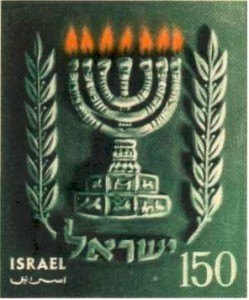 An israeli stamp for Hanukkah, with Israel‘s State Emblem, the Menora, the 7- branched Tempel-Candlestick with 2 Olive branches, the symbol of peace.
An israeli stamp for Hanukkah, with Israel‘s State Emblem, the Menora, the 7- branched Tempel-Candlestick with 2 Olive branches, the symbol of peace.
From the text of the Maccabean Books the regulations were derived, according to which the Hanukkah Holiday of Lights starts on the 25th day of the 3rd month, called Chislev. Further instructions of how to proceed with the holiday were formulated in detail by the Rabbis in the era which ended after the destruction of the second Temple in Jerusalem (in the year 70 by Titus). The regulations concerning Hanukkah are discussed in six different treatises of the Mishna. The Mishna is the written summary of the most important orally learned and collected discussions and judgements of the leading Rabbis until the year 200. At that time Rabbi Yehuda HaNasi, president of the Sanhedrin concluded the binding final collection of the commentaries and decisions named the Mishna. Actually Mishna means in Hebrew the repetitive learning. According to the tradition the decisions expressed in the Mishna were in essence forwarded from Moses to Joshua who forwarded them to the elders who later on transferred this knowledge to the Rabbis. It is important to understand that the Jewish concept recognizes the oral law called the Mishna as binding as the written Thora. After the year 200 the Rabbis continued to study and to discuss the Mishna commentaries and decisions until the middle Ages. The formal collection of these further studies are collected in the Babylonian Talmud and the Jerusalem Talmud. (Talmud means the study.) In Aramaic originally the Rabbis distinguished between the Mishna and the Talmud by calling the latter Gemara. Gemara means in Aramaic the final part following a first one. Nowadays most people call also the Jerusalem Talmud as Gemara. In addition to Talmud discussions und decisions specially regarded decisions concerning the Hanukkah Holidays were formulated by leading Rabbis like the Rambam (Rabbi Moshe Ben Maimon, Maimonides 1135 – 1204) in his famous book “Mishne Thora”. Also the leading Rabbi Joseph Caro (1488 – 1575) outlined in his highly respected book “Shulchan Aruch” the binding guidelines for the Hanukkah Holidays.
The most well known custom concerning Hanukkah is the tradition of celebrating Hanukkah for 8 days. Let us see the way it is done and the background for this: According to the story of the Creation in the first chapter of the book of Genesis a day started in the evening before. (We read: “Evening came and morning came”). Therefor Jewish holidays begin in the evening before the holiday. So the Hanukkah Holiday celebration begins in the evening before the first day by lighting the first candle in the special Hanukkah-Menorah, Hanukkah 9 branched candlestick called the “Hanukkiah”. For 8 days this evening ceremony takes place. Each evening one more candle is lit. This way the Hanukkah Holiday is concluded in the 8th day, after 8 candles were lit in the evening before. One may ask, why the Hanukkah-Menora, the Hanukkiah, has 9 arms for 9 candles, whereas the celebration takes place only for 8 days. And more basically one may ask, why the Holiday should last for 8 days. First we reply relating to the technical description of the Hanukkah-Menorah, the Hanukkiah. Since the Holiday takes place for 8 days therefore 8 candles are considered holy. Each of the 8 candles is lit by one ‘serving candle’ which is called the Shamash שמש (the servant). As a result one needs one more arm on the Hanukkah-Menorah, the Hanukkiah -candlestick, in order to put the Shamash-candle. Therefore the Hanukkah-Menora candletree, the Chanukkiya, is 9 branched.
One may mention at this point that because the Hanukkah candles serve a holy purpose their light should not serve for practical illumination. The light of the Hanukkah candles should be seen but should not be degraded to serve an additional purpose. The light of the Hanukkah candles is a direct reminder of the light of the 7 branched Menorah of the Temple. Therefore the Hanukkah lights are holy. The Hanukkah candles serve only as a reminder. The Hanukkah candles do not have to last long.
Nowadays some people use the Hanukkah-Menora, the Hanukkiah, with candles and some people keep the tradition of using oil in the Hanukkiah reminding of the oil in the Temple-Menorah.
Since Hanukkah lasts for 8 days there is at least one Shabbat-Holiday during the Hanukkah time. Because the Shabbat laws from the Thora forbid to lit fire during the Shabbat the Hanukkah candles are lit on a Friday afternoon shortly before the two Shabbat candles are lit. Consequently the Hanukkah candles are lit on a Saturday evening only after the Shabbat officially ended.
Since the Hanukkah Holiday is not a command from the Thora, the Hanukkah days are ordinary working days. Only in Israel schools take an 8 day vacation. But all shops and businesses are open.
Now we reach the core concept and reasoning for having the Hanukkah Holiday. The Jewish revolt, which was initiated by the Hasmonean family of Matityahu and his 5 sons, culminated in 168 b. C. with Yudah haMaccabee liberating Jerusalem from the Greek troupes.
The Hanukkah Miracle of the oil jug:
When Judah the Maccabee liberated Jerusalem from the Greek conquest in 164 b.c. he, of course, devoted special attention to the cleaning of the Jewish Temple on the Mount Moriah. This had to be done comprehensively because the Greeks intentionally, massively desecrated the Temple. One of the central symbols standing in the Temple was the seven branch candle tree called the Menorah. Since God is eternal, the light in the Menorah in the Temple should not cease to illuminate. Light is obviously the very best expression mankind knows, with which the thought of eternity can be expressed. We practically do not know anything in the universe which is older than light, and can obviously last as long as we can think of. Therefor the Menorah light was of crucial religious importance. The Greeks understood this importance. Therefor they deliberately destroyed all the oil jugs which were carefully stored in the Temple area.
Of course at that time the holy Temple-Menorah was not “fuelled by oil from Saudi Arabia” 🙂 . Since the time of Noah the olive tree became the symbol for peace and the covenant between God and his creation. This is the reason why the holy light in the holy Temple-Menorah had to be made from olives. In order to comply with the strict kosher regulations concerning the Temple activities there was a clear procedure of how to manufacture the kosher olive oil to be used in the Temple-Menorah. This procedure takes 8 days. The miracle of Hanukkah was, that the troops of Judah Maccabee found in the Temple only one single little olive oil jug. Normally such a little jug would suffice for only 24 hours (1 day) of the Menorah light. It meant, that one day after the re-inauguration the Menorah light would burn out. It would cause grief and sadness. Miraculously the little oil jug fueled the Temple-Menorah light for 8 days. So there was enough time to produce properly the kosher olive oil for the Temple-Menorah. There was no interruption of the Temple light.
This miracle illustrates higher help the Jews received in reward for their relentless effort to fulfil the Thora commandments.
Lighting the Temple-Menorah light in Jerusalem became therefore a universal symbol for religious enlightenment and for the freedom of religion.
A historical background for the Hanukkah Festival of Lights
In the second century b.c. the land of Israel with its Jewish population was under the rule of Greek Hellenistic kings, who had their center in Syria. The Jewish Temple in Jerusalem, which was built by the Jewish King Solomon, the son of King David, in 960 b.c. was destroyed first by King Nebuchadnezzar II (634 b.c. – 562 b.c.). Nebuchadnezzar not only conquered Jerusalem and destroyed the Jewish Temple, but also expelled the Jewish King Zidkijahu (who ruled 596 b.c. – 586 b.c.), the son of King Joshiyahu, along with ca. 10,000 people who were the elite of the country. That was the beginning of the historically important Babylonian Exile of the Jewish people. Later on the Babylonians expelled also masses of the Jewish middleclass to Babylon. After the Babylonian empire was taken over by the Persian King Cyrus (590 b.c. – 530 b.c.) things changed for the Jews. King Cyrus, who was well known for his religious tolerance, not only allowed the Jews 40 years after their expulsion from Jerusalem and Judea to return, but also to rebuild their Jewish Temple in Jerusalem.
More than 42,000 came with Zerubavel (Zerubbabel) sometime between 538-520 b.c.. The Temple was thoroughly cleaned, reconstructed and re-inaugurated in the year of 516 b.c.. (One may read about it in the for example in the Bible books of Ezra and Hagai) In the second century b.c. the Greek king Antiochus IV (215 – 164 b.c., known as Epiphanes) came to power in Syria. He ruled from 175 to 164 b.c.. The area of religious freedom and tolerance which the Jews enjoyed in Judea came to an end. King Antiochus IV was not satisfied just by ruling and squeezing the taxes. He was ambitious to force all nations of his empire to accept the Greek Gods and to give up their own religions. He enforced cruelly his standardisation of the Greek religion by law since 168 b.c.. When he heard that the Jews in Judea paid their taxes but would not obey the laws enforcing giving up their religion he sent a few armies in order to achieve his goal. He collected expert information about the strange Jewish religion which the Jews were not ready to give up. He found out that reading and learning the Thora, keeping the Shabbat Holiday and keeping the kosher food regulations were extremely important to the Jews. Mean as he was, he then released laws forbidding explicitly these Jewish activities. He hoped to break the Jewish spirit. He sent new armies reinforcing the first ones who failed to make the Jews give up their faith in their god, for whom, strangely enough, they did not even have any nice sculpture… His troops conquered Jerusalem and desecrated the Temple. His troops came to Jewish towns and villages and publicly forced Jewish citizens to eat pork since the Greeks knew that it meant for the Jews a big sin.
When the Greek troops came to the little village Modiin in the hills west of Jerusalem they followed the same procedure of provocation. They picked one Jew out of the crowd and threatened to kill him, if he would not eat pork in front of all people gathered in the central place of town. When this Jew was about to obey the Greeks, the Jewish priest Matityahu went zealotously up the stage and killed him. Yehuda the son of Matityahu then called the famous quote from the Thora (Exodus, chap. 15, Vers 11) “Mi kamocha ba Elim, Adonai” (“Who is like unto thee, O LORD, among the Gods”). He is said to have also called “Mi laAdonai, elai” (Who is on God`s side, join me). The Jewish tradition tells that this action practically ignited the Jewish national revolt against the Greeks. Since the Jewish population all over the land of Israel suffered from the cruel provocations and the religious subjugation of the Hellenistic invadors from Syria it required only this spark to set the nation on fire. People eagerly and enthusiastically joined the Jewish resistance forces under the leadership of the Priest family of Matityahu and his five sons.
Judah (Yehuda) son of Matityahu soon developed to a charismatic and highly creative military leader. He commanded the Jewish revolt troops. His motivated troops called him Judah Ha Maccabee. At first they derived the word Maccabee from the initials of his biblical sentence (Mi kamocha ba Elim, Andonai). The Hebrew word for the LORD begins with the Hebrew letter Jud. Therefore the spelling of the initials makes the word Maccabee. In English it became customary to write Maccabee with double “e” at the end, in order to pronounce the proper sound. The Maccabean troops of the Hasmonean Family found out during the battles that Judah had an extraordinary forceful blow with his arm and sword. They picked the Hebrew word מקבת “Makevet” for an ‚impact hammer’. From the word “Makevet” they also called Judah the Maccabee, meaning ‘Judah the impact hammer’. For the sound of the English letter “K” there are two Hebrew letters, Kof and Kaf, which fit the word Maccabee. With “Kaf” the word refers to the Thora verse. With “Kof” the word Maccabee refers to the hammer.
Judah Maccabee developed innovative Guerrilla combat tactics. He so succeeded to beat a number of very experienced Greek generals, for example in the valley of Bet Choron and Emaus. In the battle of Emaus Judah Maccabee miraculously managed to beat with only 6.000 men on his side the professional army of 40.000 armoured soldiers and ca. 7.000 riders of the cavallerie. This catapulted Judah the Maccabee to the status of a national hero of strategic competence.
Consistently with the original goal of re-establishing religious freedom for the Jewish people, Judah Maccabee focused on liberating Jerusalem, securing the roads to Jerusalem and cleaning the Jewish Temple from the Greek idols and all the remains from the desecrating actions of the Greeks on the Temple Mount.
Then occurred the miracle of the jug of the olive oil, which sufficed for 8 days even thou the little jug actually could provide only for one day. Since then, now for 2.178 years the Jews start on the 25th of the month of Kislev to lit the first Hanukkah Lights, one more light each evening. (Some use olive oil with wicks, some use candles.) This is done for 8 days, as described above.
The concept of liberty,
and especially of
the freedom of religion
express the universal message of Hanukkah since over 2000 years!
Der obige Beitrag zu Chanukka unterliegt dem Copyright von Ari Lipinski.
[1] For example: On Dec. 30th 2005 a public ceremony of interreligious get together took place on the central Palace Square, Schlossplatz, in Stuttgart, the capital city of the German federal state Baden-Württemberg. On this occasion the Prime Minister Mr. Guenther Oettinger and the mayor of Stuttgart Dr. Wolfgang Schuster joined Rabbi Shneur Trebnik in lighting the Hanukkah candles on a 6 meter high Hanukkiah. The City fire fighters lifted them with a professional hydraulic stage high to reach the candles. Mr. Ari Lipinski MBA, director of the Jewish community of the state of Württemberg (IRGW) at that time opened the event ceremony elaborating on the universal spirit of the freedom of religion as a common denominator of all people. He referred to the fact that at the same time worldwide similar public candle lighting ceremonies take place. Mrs. Barbara Traub M.A. warmly thanked PM G. Oettinger and Mayor Dr. W. Schuster and explicitly the big audience on the central public place who joined the first common and public interreligious ceremony of lighting the Hanukkah candles commemorating the Jewish struggle for religious freedom. This ceremony takes place since then every year.
The following photos are derived from the Website www.alemannia-judaica.de/chanukka_stuttgart_2005.htm .
From left to right: left photo: director Ari Lipinski, centre photo: Rabbi Shneur Trebnik with PM Guenther Oettinger. Right photo: f.l.t.r.: Ari Lipinski, IRGW-Cantor Arie Mozes, IRGW-Speaker Mrs. Barbara Traub MA, MP of German federate state BW G. Oettinger, Stuttgart Mayor Dr. W. Schuster.
Photo right side: f. l. t. r.: A. Lipinski, Cantor Arie Mozes, IRGW bord-speaker Barbara Traub, PM G. Oettinger and Stuttgart Mayor Dr. W. Schuster. Event: public Hanukkah candle lighting, Stuttgart.
[2] The word “Thora” means in Hebrew „teaching“ and / or guidance and instruction.
[3] In den Makkabäer Büchern sowie im sehr zuverlässigen Buch „Jüdische Altertümer“ (in Latein „Antiquitates Judaicaeקדמוניות היהודים ) von Josephus Flavius (Joseph Ben Matitjahu 37 – 100 n.d.Z.) finden wir ausführliche Beschreibungen der Entwicklung des jüdischen Aufstandes der Makkabäer sowie die Geschichte der Hasmonäer Familie nach dem Aufstand. Joseph Ben Matitjahu war der Verfasser des berühmten Buches „Der jüdische Krieg“, in Latein „Bellum Judaicum“. Er war ursprünglich seit dem Jahre 66 n.d.Z. Kommandeur des jüdischen Aufstandes gegen die Römer in Galiläa. Nachdem er von den Römern besiegt und gefangen genommen wurde, haben ihn die römischen Generäle unter dem Kaiser Titus Vespasianus zu ihrem Hof als den Chef-Geschichtsschreiber ihrer militärischen Aktionen geholt. So berichtete er außerordentlich sach-kundig sowohl über die Eroberung und Zerstörung Jerusalems durch Titus im Jahre 70, als auch über den Schlussakt der Zerschlagung des jüdischen Aufstandes in Palästina im Jahre 73 durch die Einnahme der weltbekannt gewordenen Bergfestung Massada am Toten Meer. Josephus Flavius erlebte als Hofjournalist des römischen Generals Flavius Silva die heroische Selbsttötung der Juden auf Massada. Ca. 980 Juden (inkl. Frauen, Kinder und Greise) haben 2,5 Jahre lang der römischen Weltmacht mit ihren 24.000 schwerbewaffneten Legionären die Stirn geboten. Die Juden auf Massada unter der charismatischen Führung von Elazar Ben Yair waren nicht bereit, ihren Glauben am Ewigen aufzugeben. Kein Wunder, dass Josephus Flavius (also Joseph Ben Matitjahu) sich besonders bei seiner Geschichtsschreibung auch den ihm zur Verfügung stehenden Dokumenten und Quellen aus der Zeit des jüdischen Aufstandes gegen die Griechen in den Jahren 168 v. d. Z. bis 168 v. d. Z. intensiv widmen wollte. Da Josephus Flavius ein Insider Wissen sowohl aus der jüdischen Seite als auch aus der hellenistischen Seite mitbrachte, sind seine Beschreibungen beider jüdischen Aufstände im Kampf um die Religionsfreiheit besonders wertvoll.
Tu BiShvat – The Jewish New Year of the Trees טו בשבט
(In Hebrew:Rosh HaShana LaIlanot / Rosh HaShana la Ilan).Tu Bishvat – the New Year of the Trees explained by Ari Lipinski
(Ari Lipinski was previously the chief delegate in Germany of Israel’s Aforestation Organisation KKL.
30.1.2023-ABARBANEL-ESHEL-TAMARISK-TU-BISHVAT
30.1.2023 TU BISHVAT – THE JEWISH NEW YEAR OF THE TREES – WEB–AA
Further stories and illustrations about Tu Bishvat will be added here soon.Please visit this website again soon to see the new elements. Thank you and Shalom.
Zom (Fast Day) 10th of Tevet
Purim – Erinnerung an das Los Hammans zur Vernichtung der Juden im Buch Esther.
PURIM-19.02.2023-with pictures
Pessach, Chag HaMatzot – The Holiday of Liberty, The Holiday of Questions
Abravanel-Hagaddah-Pesach-by-Ari-Lipinski
Der Auszug aus Ägypten, Das Fest des ungesäuerten Mazze-Brotes.
Obwohl im Volksmund von einem Fest, Pessach, die Rede ist, handelt es sich laut der Thora im 2. Mose (Schemot) um zwei Feste: Der erste Tag ist Pessach zur Erinnerung an das Pessach-Opfer in der Nacht der 10. Plage über Ägypten, und um 7 Tage, an denen man nur ungesäuertes Brot isst, um an die Eile des Exodus aus Ägypten zu erinnern.
Bild links oben: Mazza Schmura (Eine bewahrte Mazza). Eine besondere Mazza, bei deren Vorbereitung bereits von der Ernte des Weizens am Felde die Körner vor dem Kontakt mit jeglicher Feuchtigkeit bzw. mit Wasser oder Häfe bewahrt werden, um jeden Säuerungsprozess zu verhindern. Der Transport und die Produktion finden nur mit eigens für Pessach strikt von Häfe und von Feuchtigkeit freien Mitteln statt. Denn es gilt laut der Vorschrift der Thora im 2. Mose (Buch Schemot), dass man ungesäuertes Brot essen solle.
Im Bild rechts oben sehen wir eine Standard-Mazza mit der viereckigen Form. Sie ist auch ungesäuertes Brot. Allerdings wurde nur das Mazze-Mehl beim raschen Backvorgang davor bewahrt, dass es nicht säuerlich werde. Ob die Weizenkörner auf dem Weg bis zur Mehlproduktion feucht geworden waren ist unbekannt. Der Hersteller verpflichtet sich nur für die Koscher-für Pessach-Kontrolle in der Bäckerei, nicht für die Vorgänge vom Feld bis zur Bäckerei.
Ari-Lipinski-Artikel-Abarbanel-über-Pessach-als-Fest-der-Fragen
Heutzutage gibt es eine Vielfalt von Mazza-Brote (Das Bild stammt von Jacques Korolnyk).
Yom HaZikaron LaSHOA ve LaGevura (The memorial Day for the SHOA and the Heroism). In Israel it is according to the Jewish date of the beginning of the Jewish Revolt in the Ghetto of Warsaw which was on the 19.4.1943. The EU and the UN chose to commemorate the Victims of the SHOA with a Holocaust Memorial Day according to the 27.1.2945, when the Russian Red Army liberated the German Nazi Concentration Camp Auschwitz. The troop was under the command of the Jewish Major Anatoly Shapiro.
Yom HaZikaron leChalelei Zahal uMaarchot Israel
Yom HaAzmauth
Lag BaOmer
SHAVUOT (PENTECOST) חג שבועות
The 8 Names of the Holiday
SHAVUOT-2017- The 8 names of the Feast of Weeks






